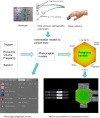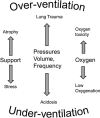Transparent decision support for mechanical ventilation using visualization of clinical preferences
- PMID: 35073928
- PMCID: PMC8785460
- DOI: 10.1186/s12938-021-00974-5
Transparent decision support for mechanical ventilation using visualization of clinical preferences
Abstract
Background: Systems aiding in selecting the correct settings for mechanical ventilation should visualize patient information at an appropriate level of complexity, so as to reduce information overload and to make reasoning behind advice transparent. Metaphor graphics have been applied to this effect, but these have largely been used to display diagnostic and physiologic information, rather than the clinical decision at hand. This paper describes how the conflicting goals of mechanical ventilation can be visualized and applied in making decisions. Data from previous studies are analyzed to assess whether visual patterns exist which may be of use to the clinical decision maker.
Materials and methods: The structure and screen visualizations of a commercial clinical decision support system (CDSS) are described, including the visualization of the conflicting goals of mechanical ventilation represented as a hexagon. Retrospective analysis is performed on 95 patients from 2 previous clinical studies applying the CDSS, to identify repeated patterns of hexagon symbols.
Results: Visual patterns were identified describing optimal ventilation, over and under ventilation and pressure support, and over oxygenation, with these patterns identified for both control and support modes of mechanical ventilation. Numerous clinical examples are presented for these patterns illustrating their potential interpretation at the bedside.
Conclusions: Visual patterns can be identified which describe the trade-offs required in mechanical ventilation. These may have potential to reduce information overload and help in simple and rapid identification of sub-optimal settings.
Keywords: Clinical decision support; Clinical preferences; Mechanical ventilation.
© 2022. The Author(s).
Conflict of interest statement
DSK and SER are minor shareholders and SER a board member of Mermaid Care A/S the manufacturer of the Beacon Caresystem. JBB is an employee of Mermaid Care A/S.
Figures



References
MeSH terms
LinkOut - more resources
Full Text Sources

